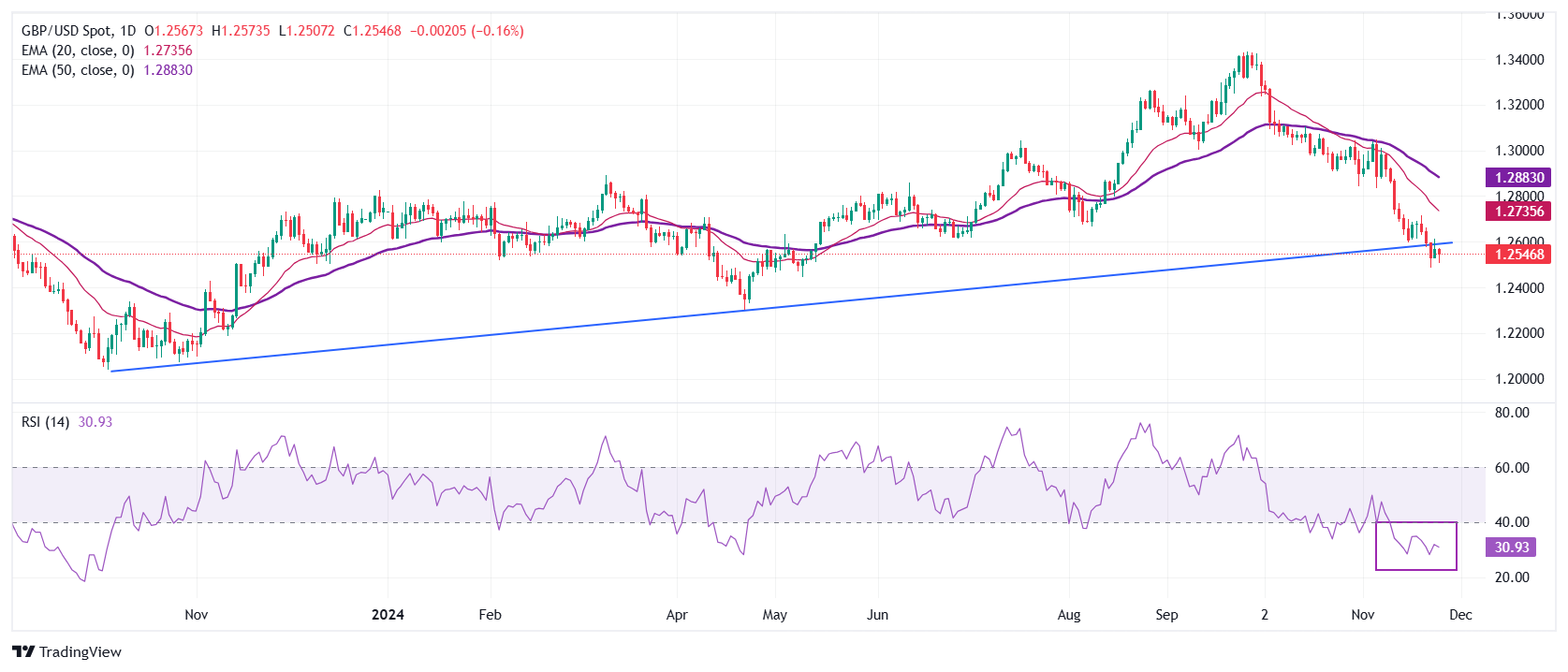- The British pound is trading lower against the US dollar as Donald Trump warns of more tariffs on other North American economies.
- Investors await FOMC minutes on Tuesday and PCE inflation data for October on Wednesday.
- BoE’s Lombardelli supports a gradual approach to policy easing and warns of upside risks to inflation.
The British Pound (GBP) recovers some losses against the US Dollar (USD) in the London session on Tuesday after falling near the psychological support of 1.2500 in Asian trading hours. GBP/USD rebounds as US Dollar gives up most intraday gains after strong open.
The US Dollar Index (DXY), which tracks the value of the USD against six major currencies, had a stellar opening after President-elect Donald Trump warned he would impose 25% import tariffs on all products from Canada and Mexico . Trump added that there will be an additional 10% tariff on imports from China for bringing illicit drugs into the United States (US) through Mexico.
However, the dollar has given up more than half of its gains on expectations that Trump’s nomination of Scott Bessent for Treasury Secretary would maintain geopolitical stability while delivering on Trump’s economic agenda. In an interview with the Financial Times (FT) over the weekend, Bessent said he would focus on enacting tariffs, however the targets would be “implemented gradually.”
On the monetary policy front, investors await US Personal Consumption Expenditure Price Index (PCE) data for October, due out on Wednesday. Economists expect inflation data to have accelerated from September readings in annual terms. It is estimated that the PCE general and underlying inflation data month by month have grown steadily.
Inflation data will significantly influence market expectations about the Federal Reserve’s (Fed) likely interest rate action at the December meeting. The probability that the Fed will cut interest rates by 25 bps to the 4.25%-4.50% range in December is 56%, while the remainder favors the central bank choosing to keep interest rates stable, according to the tool CME FedWatch.
In Tuesday’s session, investors will focus on the Federal Open Market Committee (FOMC) minutes of the monetary policy meeting held on November 7, which will be published at 19:00 GMT. At the monetary policy meeting, the Fed cut interest rates by 25 basis points (bps) to the range of 4.50%-4.75%.
Daily Market Summary: Pound Firms Amid Uncertainty Over BoE Interest Rate Path
- The British pound is trading broadly sideways against its major peers on Tuesday, with investors looking for fresh clues on the likely path of Bank of England (BoE) interest rates. Most BoE policymakers, including Governor Andrew Bailey, have supported a gradual approach to policy easing, citing lingering concerns about price pressures.
- BoE deputy governor Clare Lombardelli said in a speech at King’s Business School on Monday, “I support a gradual removal of monetary policy tightening.” Lombardelli warned of the risks of inflation remaining higher than the bank forecast, with wage growth normalizing at 3.5%-4% and the Consumer Price Index (CPI) around 3% instead of 2%.
- When asked about economic performance in the context of weak preliminary S&P Global/CIPS Purchasing Managers’ Index (PMI) data for November, Lombardelli said, “November’s preliminary PMIs may suggest a slowdown in the U.S. economy. United Kingdom (UK), but I don’t take a strong signal from a single publication.”
- By contrast, BoE policy outsider Swati Dhingra appears to support a less gradual approach to interest rate cuts as she does not see the UK as an inflation outlier among advanced economies. Dhingra added that politics is weighing on investment.
- Traders currently expect the BoE to keep interest rates unchanged at 4.75% at the December policy meeting.
Technical Analysis: Sterling remains vulnerable above 1.2500
The British Pound remains below the ascending trend line near 1.2550 against the US Dollar, which is drawn from the October 2023 low around 1.2040. The GBP/USD outlook remains bearish as the 20-day and 50-day exponential moving averages (EMAs) at 1.2735 and 1.2883, respectively, are tilted lower.
The 14-day Relative Strength Index (RSI) is oscillating within the range of 20.00-40.00, suggesting that the downward momentum is intact.
Looking down, the pair is expected to find support near the May low of 1.2446. To the upside, the November 20 high around 1.2720 will act as key resistance.
The British Pound FAQs
The British Pound (GBP) is the oldest currency in the world (AD 886) and the official currency of the United Kingdom. It is the fourth most traded foreign exchange (FX) unit in the world, accounting for 12% of all transactions, averaging $630 billion a day, according to 2022 data. Its key trading pairs are GBP/ USD, which represents 11% of FX, GBP/JPY (3%) and EUR/GBP (2%). The British Pound is issued by the Bank of England (BoE).
The most important factor influencing the value of the Pound Sterling is the monetary policy decided by the Bank of England. The Bank of England bases its decisions on whether it has achieved its main objective of “price stability” – a constant inflation rate of around 2%. Its main tool to achieve this is the adjustment of interest rates. When inflation is too high, the Bank of England will try to control it by raising interest rates, making it more expensive for people and businesses to access credit. This is generally positive for sterling, as higher interest rates make the UK a more attractive place for global investors to invest their money. When inflation falls too much it is a sign that economic growth is slowing. In this scenario, the Bank of England will consider lowering interest rates to make credit cheaper, so that companies will take on more debt to invest in projects that generate growth.
The data released measures the health of the economy and may affect the value of the pound. Indicators such as GDP, manufacturing and services PMIs and employment can influence the direction of the Pound.
Another important piece of information that is published and affects the British Pound is the trade balance. This indicator measures the difference between what a country earns from its exports and what it spends on imports during a given period. If a country produces highly in-demand export products, its currency will benefit exclusively from the additional demand created by foreign buyers seeking to purchase those goods. Therefore, a positive net trade balance strengthens a currency and vice versa in the case of a negative balance.
Source: Fx Street
I am Joshua Winder, a senior-level journalist and editor at World Stock Market. I specialize in covering news related to the stock market and economic trends. With more than 8 years of experience in this field, I have become an expert in financial reporting.








